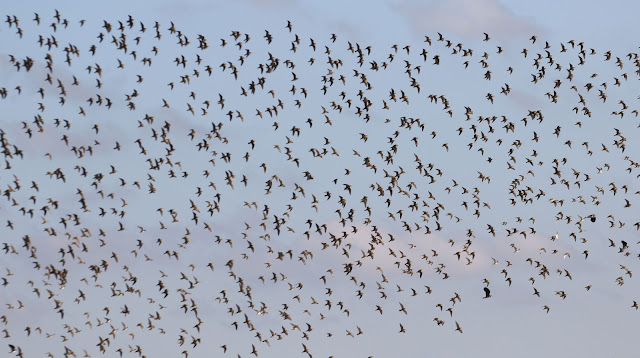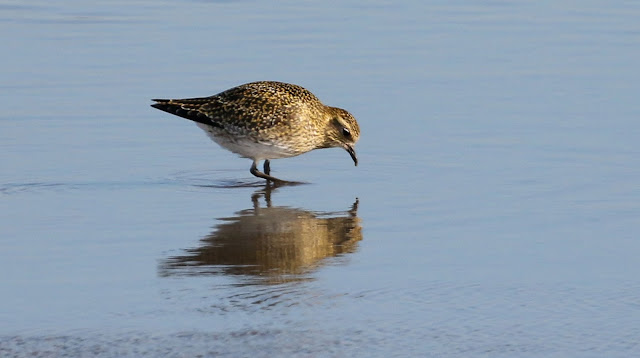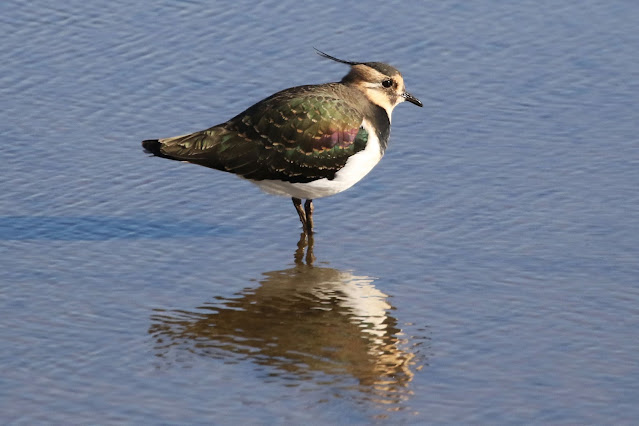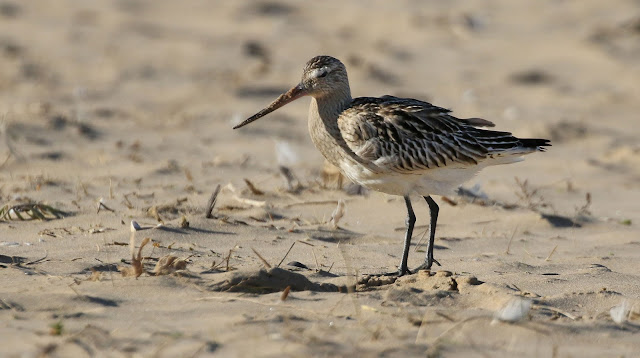An opportunity for a short break in Norfolk saw us leaving early in the morning, the quickest route would have taken us around the M25, but I decided to avoid this stretch of road due to the resumed Insulate Britain demonstrations that have been causing chaos recently. I know that they never really start early, but I decided to be cautious. This meant we arrived at the car park at RSPB Snettisham just before 10:30 after having some breakfast along the way.
The reason we were here was because of the high tide being just before mid day and hopefully this would produce some of the spectacular wader views, out on the Wash thousands of mostly Knot gather and are forced off the mud by the rising tide. It is about a mile walk to the beach from the car park, a walk that was into a very strong southerly wind. As we reached the beach with about forty five minutes to the designated high tide I was very disappointed to see the following sight.
I was hoping there would be a sudden surge in the tide, but I was doubting myself as well. I checked the tide times once again and noted the tide height, it was below five metres and looking ahead, tides later in the week were just under six metres, once again a trip to Snettisham looks like it was going to disappoint.
Scanning across the beach there was a dark black line
Looking closer the black line belonged to a huge gathering of Oystercatchers, probably all coming together on sensing the rising tide.
We walked south along the sea wall, the strong southerly wind in our faces and this was also probably contributing to the low state of the tide. Looking south it was getting harder to imagine the tide would cover the mud.
We reached the Rotary Hide and rather than go in stood out of the wind alongside the hide. Out on the mud a large flock of Golden Plover were spooked by something and produced what was going to be our only wader display of the morning.
Knot could be seen distantly, covering the mud, I tried t imagine what they would have looked like as the wheeled around evading the rising water, it wasn't a good substitute for what I had hoped we would see.
Curlew were in the many gullies and a Little Egret hunted close by. Every so often a Redshank would call and fly over to the pits behind while the odd Black-tailed Godwit would fly past. Scanning the mud towards the south I picked up a single Marsh Harrier struggling in the wind, as a result it stayed very distant and never came close.
Of the duck, Shelduck appeared the most numerous, standing out with the white plumage against the dark mud. There was no doubt there were other duck present, but most were sheltering in the gullies from the wind and on the streams of water that had pushed closer. A small group of Wigeon flew across the mud towards us, eventually passing over our heads.
By the tide timetable I had it was now high tide, but as you can see there was still acres of mud visible, the Golden Plover settled in a long golden line across the mud
Now resigned to the fact that the tide was never going to rise and that once again a trip to this reserve had proved to be a waste of time we decided to move on, the next proposed stop was to be the RSPB reserve at Titchwell Marsh, about 20 miles around the coast.
With it being half term we expected a full car park and that was what we found, although we managed to find a space. After a lunch of a very nice sausage bap we walked out on to the marsh, following the raised path out towards the beach.
The first sight that greeted us was a wheeling flock of Golden Plover, everything as large as the flock we had seen at Snettisham. They had taken off from the Freshwater Marsh and along with Lapwing and a few duck were circling above the marsh. There did not appear to be any threat from predators.
Eventually they settled and joined many more that were all standing on the mud islands created in the marsh. In the autumn sunshine their golden plumage stood out and there must have easily been around 1000 birds present. Here some views of them on the ground.
The view across the marsh, looking east was spectacular with the sky now a deep blue.
The Golden Plover were still quite unsettled and were up once again, a blizzard of wings and flashes of white and gold as they turned this way and that.
Panning out, this was still a sample of the number of birds that there was up in the air
We sat on one of the benches over looking the marsh, close to the path the water was shallow and still, making an excellent reflection pool, some of the Golden Plover were spreading out on to the water along with Lapwing and Dunlin. I was waiting for the plover to spook once again, but now they seemed to be settled so I turned to the birds that had edged a little closer.
Up close you can see the beautiful spangled colours of gold, and brown picked out by the sunshine.
The summer breeding plumage is stunning with a black chest and belly replacing the white in the winter plumage, but even so they are a stunning bird to appreciate up close.
Several of the birds were quite feisty, and if one came too close, or another decided they wanted the space there was a short sharp "to do" before settling down
The Golden Plover were joined by a Teal crossing the pool.
And a few Lapwing, showing off the bottle green and petrol colours in their plumage
With the Golden Plover looking settled and not likely to take to the air, we decided to make our way down to the beach. As expected following the experience at Snettisham, the tide was out and we were faced with a beautiful beach stretching out under a lovely blue autumnal sky.
We turned west and almost immediately came across a single Bar-tailed Godwit feeding almost under the dunes, somewhere I would not have expected to find one, clearly it was separated from others that could be seen down ate the water's edge.
While wary of any danger from above it was quite approachable. I was able to get closer and down low to its height.
Moving on I was looking to find the reported Snow Buntings, stopping to ask a couple of birders they said they had seen two close to the dunes. We walked on, moving beyond where they had been seen and then walked back and it didn't take long to find the first bird.
This is a winter plumaged female and was searching the sand in the lee of the dunes and around the stems of the marram grass.
They are always confiding birds, being easy to approach close.
Then it did something I have not seen a snow bunting do before, it jumped on to a stem of grass and moved down towards the seed head.
Balancing on the thin stem gave some problems and it struggled for its balance.
But finally was able to reach the seeds at the end of the stem.
Leaving the dunes I could see a group of Sanderling on the edge of the water and a good sized flock of Bar-tailed Godwits. Unfortunately as I started to head towards them they were disturbed by some dogs and the flocks scattered. I returned to the dunes and came across the single Bar-tailed Godwit once again. This time closer to the bank of sand.
It then moved out of the shade caused by the dunes and into the sunshine.
I let the godwit move on as I had seen another Snow Bunting feeding below the dune.
Another female bird, this one was probably more approachable.
Certain birds are more photogenic and sort after than others and the Snow Bunting is one of those birds. One or two come through Hampshire each year, but not guaranteed, so it was nice to catch up with these birds today.
We continued to walk towards the east and finally managed to come across a few Sanderling, their silver grey plumage standing out against the dark brown of the wet, sunlit sand.
Sanderling are another of those photogenic birds.
Off shore there were several Great Crested Grebes, but a little further were up to twenty Red-throated Divers.
Then a big and very pleasant surprise, a very small auk, with a small beak and black and white, a Little Auk, my first for a very long time and the first I have seen settled on the water, in the past they have been a blur as they fly past. This was the best image I could achieve.
Also on the beach were good family groups of Brent Geese, there appear to be good numbers of this year's young, travelling with their parents. I love the colours from the beach, the sea nd sky in these photographs.
A few large gulls such as Great Black-backed and this Herring Gull also stood at the edge of the water, their white plumage reflecting in the surf.
While it is a beautiful beach with views stretching out for miles east and west, looking out to sea the view is overtaken by the sheer volume of wind turbines. A necessity in this day and age and one of the many reasons why the UK has a very good carbon neutral power supply, but the presence of these monsters is something you either loathe or like.
With time moving on we returned to the reserve, walking past the saltwater marsh and stopping once again at the Freshwater Marsh. The light was even better now with the sun much lower in the sky.
A drake teal, the sunshine catching the speculum and in this light it was showing a vivid green, but in other light can also come up a mauve or purple
It was the Lapwing this time though that caught the eye, reflecting the stunning green plumage in the low sun and reflecting in the mirror like water.
A single Black-tailed Godwit stretched its wing to show off the white wing bar that distinguishes them in flight from the smaller Bar-tailed Godwit.
As we left the marsh I stopped to take in the view once more. The Golden Plover were scattered across all the islands and available mud, the low sun light picking them out, while above a flock of Brent Geese flew in from the beach.
Despite the disappointment of the tide at Snettisham it had turned out to be a lovely day, some quality birds in spectacular surroundings, Norfolk is very special









































































No comments:
Post a Comment